|
|
|
|
|
|
|
|
|
|
© 2005-2015
Jan Bender

|
|
 |
Our Tangley Calliaphone
Our ST-58 Tangley Calliaphone was custom built for us in 2002. It is the first of its kind in the world! Unlike the old calliopes that were designed primarily to be loud, it has a musical “brass organ” sound. In addition to having more than the usual number of 43 whistles, it was voiced to be more mellow, and it has a pipe organ blower that gives a more even sound throughout the tonal range.
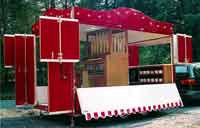 The calliope and trailer as delivered. The calliope and trailer as delivered.
The case is quartersawn oak in an Arts and Crafts style, also a first. The unique Lexan hood over the whistles has swell shutters. Yes, a calliope with volume control! With the shutters closed, you can actually stand next to it and talk. It is powered by electricity (either through a regular power cord or by a quiet generator), and is usually “played” using special punched paper rolls. |

Why did we want this instrument?
We have three smaller street organs, and Terry performs as an organ grinder at events such as craft fairs. We wanted an instrument that was appropriate for larger venues, but we wanted it to have a musical sound. |
|
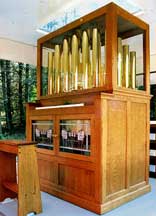 |
|
| A friend recommended talking with the late Dave Miner of Miner Manufacturing in Donnelson, Iowa, about custom building a new calliope. Miner Manufacturing (now Miner Company in Kirksville, Missouri) owns the old Tangley Calliaphone name now and has continued building the popular 43 whistle model Tangley manufactured originally from 1913 - 1931. |
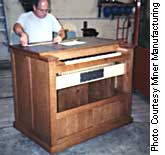
Measuring for the whistle layout.
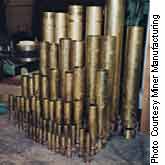
The new whistles before being buffed and laquered.
|
How was it made?
Dave agreed to design a new instrument for us. We wanted the full 58 whistles, an instrument that played with either punched rolls or a keyboard, a quartersawn oak case in Arts and Crafts period style (a furniture style popular in 1915 but not used for calliopes then), a more musical tone, and some way to control the volume.
We also wanted a circus-like trailer that had room to store the rolls and that opened fully so that the instrument could be seen easily. |
Basically, Dave kept saying, “Yes”, until we finished asking. He incorporated our ideas and developed many additional new features in the design process.
In the photos, Dan Dohman is shown building our calliope.
Dan Dohman is now the owner of Miner Company, the successor company following Dave Miner's untimely death in September, 2008. A link to the Miner Company website is on our "Links" page. |
|
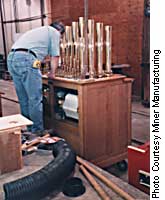
|
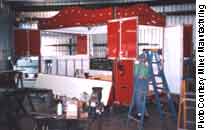 |
Miner Manufacturing built both the calliope and the trailer. The custom built trailer opens to provide a stage setting for the calliope and has room to store the punched paper rolls.
|
|
Dave delivered the calliope and trailer personally in August 2002. It was everything we wanted and more. Dave was also able to provide many rolls. These are newly repunched reproductions of the old “A” Rolls traditionally used in the Tangley Calliaphones.
|
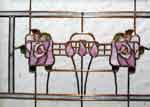 |
The stained glass windows in the doors were designed and made by the late Erwin Straubinger, of Springfield, Virginia. Working in the Arts and Crafts style of stained glass, he added the finishing touch to this landmark instrument. |
For performances, we add circus theme decorations including reproductions of historic posters from Circus World, Baraboo, Wisconsin. This instrument represents a major advance in the design of American calliopes.
Back to Top
|
|
| |
 |
| |
What does the Lexan hood do?
Why are punched paper rolls used?
Why have 58 whistles?
|
|
| |

|
|
|

